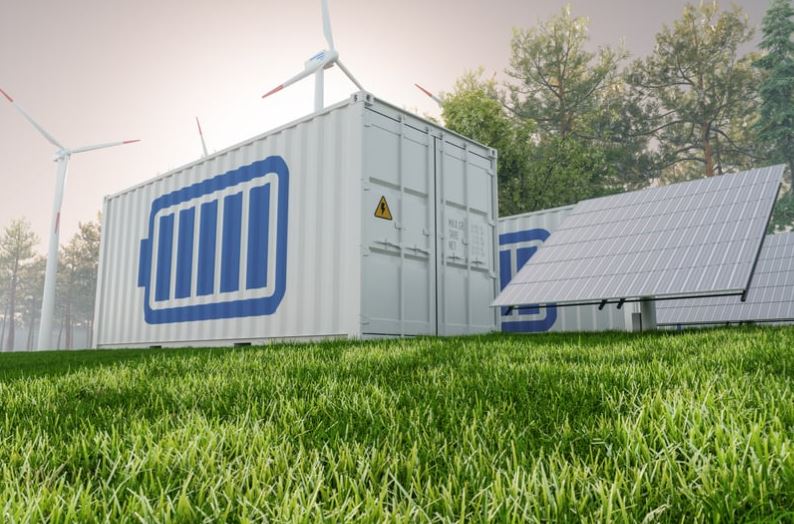Associated British Ports Southampton and BW ESS will develop a battery energy storage system at Marchwood Industrial Park following New Forest District Council planning approval, targeting late 2028 commissioning with a 40-year operational lifespan. The facility’s proximity to Marchwood National Grid Substation enables grid connection with minimal infrastructure extension—a siting advantage that reduces capital costs and transmission losses compared to remote storage deployments.
The seven-acre brownfield redevelopment converts obsolete industrial structures into grid-balancing infrastructure as the UK accelerates utility-scale battery deployment to manage renewable energy intermittency. Battery energy storage capacity in Great Britain reached 4.7 GW by mid-2025 according to National Grid ESO data, up from 2.3 GW in 2023, with project pipelines suggesting 15-20 GW by 2030. The Marchwood facility joins this expansion wave, though specific capacity specifications remain undisclosed in available project announcements.
Grid-Adjacent Siting Reduces Connection Costs
Marchwood National Grid Substation’s immediate adjacency eliminates transmission infrastructure requirements that typically add £2-5 million per mile for high-voltage connections. Battery storage facilities located distant from substations incur both higher capital costs for dedicated transmission lines and ongoing energy losses during electricity transport. Direct substation connection at Marchwood maximizes round-trip efficiency—the ratio of electricity discharged to electricity consumed during charging—which averages 85-90% for lithium-ion systems but degrades with transmission distance.
The brownfield designation addresses land use concerns that have delayed battery storage projects in greenfield locations where agricultural or conservation interests object to industrial energy infrastructure. England’s planning system prioritizes brownfield redevelopment, and the Department for Energy Security and Net Zero’s recognition of battery storage as essential electrical infrastructure strengthens applications against local opposition. New Forest District Council’s approval suggests this project encountered minimal resistance compared to greenfield proposals that frequently face extended planning battles.
ABP Southampton’s asset manager Tim Hook frames the development as “regenerating a brownfield site for clean energy,” though battery storage itself generates no electricity—it time-shifts existing generation. This distinction matters for understanding grid economics. Battery facilities profit from price arbitrage: charging when wholesale electricity prices drop during high renewable generation or low demand periods, then discharging when prices spike during supply scarcity. The value proposition depends on price volatility, which increases as variable renewable generation expands.
Economic Model Relies on Balancing Mechanism Revenue
UK battery storage revenue streams combine multiple markets. The Balancing Mechanism pays facilities to increase or decrease output in response to National Grid ESO instructions, maintaining system frequency and voltage within operating limits. Frequency response contracts provide ongoing payments for automated response to grid frequency deviations. Capacity Market auctions secure payments for availability during periods of forecast electricity supply tightness. Wholesale arbitrage captures price differentials between charging and discharging periods.
Revenue stability varies across these streams. Capacity Market contracts provide predictable annual income but at declining auction clearing prices—recent auctions cleared at £6-8 per kW-year, down from £15-20 in earlier years as battery capacity proliferated. Balancing Mechanism and frequency response revenues fluctuate with system conditions and competitor activity. As battery storage capacity grows, these ancillary service markets become saturated, reducing unit revenues unless electricity system volatility increases proportionally.
The 40-year operational lifespan cited by BW ESS exceeds typical lithium-ion battery warranty periods of 10-15 years or 3,000-5,000 cycles. This suggests either conservative utilization assumptions—cycling once daily rather than the 2-3 daily cycles economically optimal for arbitrage—or expectations of battery replacement after initial degradation. Lithium-ion batteries lose capacity through repeated charge-discharge cycles, with performance declining to 70-80% of original capacity after warranty thresholds.
Battery replacement costs constitute significant lifecycle expenses that project financial models must accommodate. Initial capital costs for utility-scale lithium-ion systems range £300-450 per kWh installed capacity, with replacement costs projected to decline 40-50% by the 2030s as manufacturing scales and technology improves. A facility requiring battery replacement after 15 years faces substantial capital calls that must be financed from accumulated operating revenues or refinancing.
Technology Selection and Capacity Considerations
BW ESS’s track record suggests lithium-ion chemistry, given the company’s portfolio focus, though project announcements omit explicit confirmation. Alternative technologies—flow batteries, compressed air energy storage, or newer chemistries like sodium-ion—offer different performance profiles. Lithium-ion dominates UK deployments due to proven reliability, established supply chains, and declining costs. Flow batteries provide longer discharge durations (4-10 hours versus 1-4 hours for lithium-ion) but at higher capital costs per kW and lower round-trip efficiency.
Duration selection—the hours of discharge at rated power—reflects intended market participation. One-hour systems optimize for frequency response, requiring brief high-power bursts. Two-hour systems balance frequency response and intraday arbitrage. Four-hour systems target wholesale market arbitrage and capacity market participation, requiring sustained discharge during evening demand peaks. UK planning applications increasingly specify 2-4 hour systems as market analysis indicates optimal revenue combinations in those ranges.
The seven-acre footprint constrains capacity scaling. Utility-scale battery installations achieve densities of 15-25 MW per acre, including transformer and auxiliary equipment areas. This suggests Marchwood could accommodate 100-175 MW capacity, translating to 200-700 MWh energy storage at typical duration ratios. Without confirmed specifications, these remain estimates, but they position the facility in the mid-tier of UK battery projects—smaller than the largest 500+ MW installations but substantial compared to the 50 MW median for projects commissioned since 2023.
Port Authority Diversification Strategy
ABP Southampton’s battery storage venture extends port authority participation in energy infrastructure beyond traditional maritime logistics. UK ports increasingly host or develop renewable energy projects—offshore wind O&M bases, hydrogen production facilities, biomass import terminals—leveraging waterfront industrial land and electrical grid connections. This diversification provides revenue streams independent of cargo throughput volatility while aligning with decarbonization objectives that affect port operations through shipping emissions regulations.
Ports face energy transition pressures as shore power requirements for berthed vessels, electrified cargo handling equipment, and potential maritime fuel production (hydrogen, ammonia, methanol) increase electricity demand. Co-locating battery storage with anticipated load growth enables ports to manage peak demand charges and enhance power quality for sensitive equipment. Marchwood’s battery facility might serve dual purposes: grid services generating commercial returns and local supply resilience supporting port operations during grid disturbances.
The long-term lease structure, ABP retains land ownership while BW ESS operates the facility—aligns with port authority risk management preferences. Capital investment and operational responsibilities transfer to the specialist energy storage developer, while ABP secures lease income and potential strategic benefits from on-site electricity storage. Lease terms undisclosed in public announcements likely include revenue-sharing mechanisms or facility access provisions benefiting both parties.
Grid Integration Timing and Market Context
The late 2028 operational target positions commissioning when renewable generation capacity is projected to reach 65-70 GW across wind and solar, up from 45 GW in 2025. This expansion increases system volatility, requiring flexible balancing resources. National Grid ESO’s Future Energy Scenarios model 15-24 GW of battery storage by 2030 across different decarbonization pathways, indicating that Marchwood enters an expanding but increasingly competitive market.
Competition affects revenue projections embedded in BW ESS’s investment decision. Early-mover battery projects captured outsized revenues in undersupplied ancillary service markets. As capacity additions accelerate, marginal revenues decline unless concurrent changes—higher renewable penetration, increasing volatility, electricity market reforms creating new revenue streams, or coal and gas plant retirements reducing alternative flexible capacity—maintain demand for storage services.
UK electricity market reforms under consideration include locational marginal pricing, enhanced frequency response products, and modifications to capacity market rules affecting battery participation. These policy developments create uncertainty for long-duration investment commitments like Marchwood’s 40-year horizon. BW ESS’s investment implies confidence that regulatory frameworks will maintain or improve battery storage economics despite capacity growth pressures on existing revenue mechanisms.
The facility’s contribution to “local energy security,” cited by BW ESS Executive Director Richard Thwaites, requires qualification. Battery storage provides system-level flexibility rather than localized supply assurance—electricity dispatches wherever National Grid ESO direct,s regardless of storage facility location. During regional supply constraints, batteries charge if local generation exceeds demand or discharge if supply falls short, but this responds to price signals rather than geographic priorities. Genuine local resilience requires islanding capability and dedicated load-serving commitments typically absent from grid-connected merchant storage facilities.
Southampton’s industrial and residential electricity demand exceeds what Marchwood’s estimated 100-175 MW capacity could supply during extended outages. The facility’s value manifests in grid-wide balancing that indirectly benefits all connected customers through enhanced system stability and renewable integration—diffuse benefits that don’t concentrate in the immediate vicinity despite proximate siting.
The brownfield redevelopment aspect addresses broader UK challenges with land availability for energy infrastructure. Competition for developable land intensifies as solar farms, battery storage, data centers, and housing developments bid for suitable sites. Prioritizing brownfield utilization—particularly parcels with existing grid connectivity—maximizes infrastructure value per acre while minimizing greenfield conversion. Marchwood exemplifies this approach, though the number of comparably situated brownfield sites adjacent to major grid substations limits replication potential at scale.

